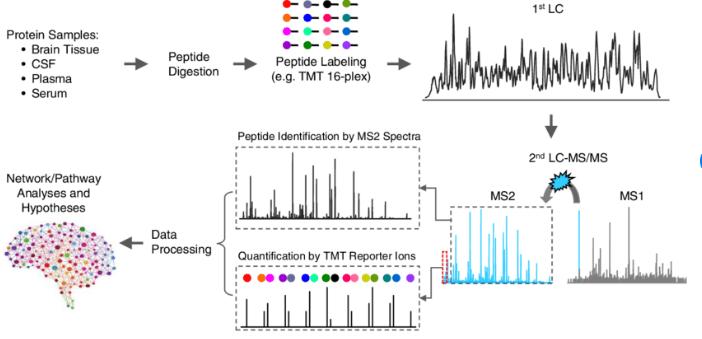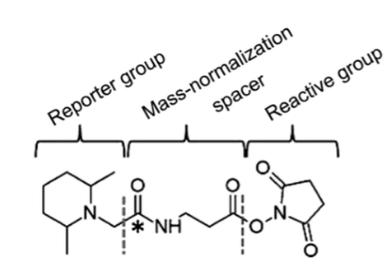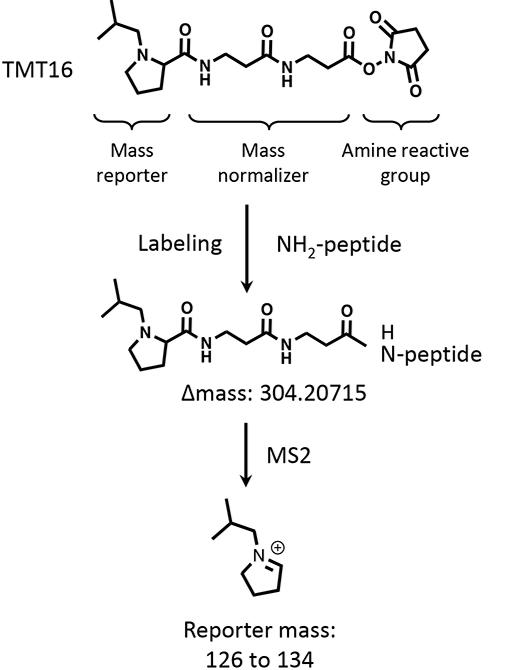Mass spectrometry has been widely used in both general protein quantification and the study of protein translation modifications, making it one of the primary analytical techniques for proteome quantification. Based on whether the target protein is quantified, it can be divided into untargeted quantification and targeted quantification. Untargeted quantification can further be classified into label-free quantification and labeled quantification, depending on whether labeling is performed.
Some stable and practical protein quantification mass spectrometry techniques that have been retained based on scientific research and clinical needs are still being continuously improved and developed. The iTRAQ, which used to allow labeling of up to 8 samples, has now been surpassed by the TMT, which allows labeling of up to 16 tags. This article provides a summary of the current progress and applications of mainstream techniques for protein untargeted quantification-TMT.
Protein Untargeted Quantification
Untargeted quantitative proteomics is a technique that allows for unbiased quantification of all proteins in a sample. There are two types of methods used for untargeted quantification: labeled and label-free quantification.
Labeled Quantification
Labeled quantification techniques involve the addition of isotopic labels to different protein samples. One representative technique in this category is TMT (Tandem Mass Tag), which is a chemical labeling technique used in vitro.
TMT Principle
The key to labeled quantification lies in the labeling reagents, which utilize the principle of isotopes. Different isotopic labels are connected to specific amino acid residues in peptides, allowing for the labeling of peptides from different sources. TMT offers isotopic labels in various multiplexing levels, including 6-plex, 10-plex, 11-plex, and 16-plex. Each multiplexing level has its own reagent kit. For example, the 10-plex TMT kit contains ten isotopic compounds with identical chemical structures but different elemental compositions (i.e., isotopic compounds with the same mass). Each label consists of an Amine Reactive group, a Mass Normalizer, and a Mass Reporter.
The Mass Reporter forms different molecular weights using different types of isotopes, while the Mass Normalizer reduces the molecular weight to ensure that the sum of the relative molecular weight of each Mass Reporter and Mass Normalizer is equal. For instance, if the relative molecular weights of three Mass Reporter groups are 126, 127, and 128, then the relative molecular weights of the Mass Normalizer region would be 103, 102, and 101, respectively, adding up to 229. Mass spectrometry detects based on mass-to-charge ratio (m/z), so it is crucial to ensure that the same peptide from different sources with the same label has the same m/z in the primary mass spectrum.
The process involves digesting different protein samples into peptides, labeling different samples with different labeling reagents, and thus attaching different labels to different peptide segments. The Amine Reactive group reacts with the N-terminus of amino acids or lysine residues. In the primary mass spectrum, the same peptide segment from different sources appears with the same m/z after labeling and elutes at the same retention time. In the secondary mass spectrum, the Mass Normalizer dissociates, resulting in different Mass Reporter peaks for the same peptide segment labeled with different tags. The peak areas of different Mass Reporters reflect the abundance of the peptide segment in the corresponding sample. By comparing the peak areas of different Mass Reporters, differences in expression of a specific peptide segment among different samples can be identified. The m/z of peptide fragment ions reflects the sequence information of the peptide segment. Through database searching of the raw mass spectrometry data, quantitative information about the proteins can be determined.

Figure 1: TMT Quantification Workflow.
TMT and TMTpro
TMT currently has two sets of reagent schemes: TMT and TMT “extended version,” known as TMTpro. The TMT scheme refers to the traditional TMT labeling scheme. Initially, it allowed for up to 6-plex quantification, which was later expanded to a maximum of 11-plex by incorporating additional isotopic combinations. However, the labeling molecular structures remained the same. TMTpro is the latest scheme, designed to accommodate more isotopic combinations by expanding the Reporter and Normalizer regions. Currently, TMTpro enables up to 16-plex quantification, employing the same principles as TMT. TMTpro utilizes Reporter groups with masses around 126-134 Da to provide quantitative information. Among them, 126 and 134 Da exhibit single peaks, while the rest represent N14 and C14 isotopic peaks, resulting in a total of 16 different isotopes.


Figure 2: Schematic representation of the chemical structure and functional regions of TMT and TMTpro labeling.
TMT Characteristics and Applications
Compared to label-free quantification: TMT utilizes different labels added to the samples to distinguish and quantify proteins, allowing for the simultaneous analysis and comparison of multiple samples in a single run. The data acquisition mode of TMT is single-run, enabling the quantification of up to 16 samples simultaneously. Compared to conventional label-free quantification using unique peptide-based data-dependent acquisition (DDA) mode, TMT provides fewer missing values and more complete data recording. Label-free quantification often suffers from poor reproducibility in detecting multiple batches of samples, while TMT can identify more proteins through fractionation compared to label-free techniques. However, due to the scan mode limitations of DDA, low-abundance proteins may be underrepresented. Additionally, the presence of dynamic range compression may result in lower quantification values compared to actual values, making it challenging to accurately quantify differentially expressed proteins.
Therefore, label-based quantification, such as TMT, is more suitable for comparing shared proteins among small samples (up to 16) with similar backgrounds (e.g., same species and sample types) subjected to various treatments or different time points. However, it is not suitable for identifying the presence or absence of proteins in the samples.
TMT Compared to iTRAQ
In the early stages, TMT had limitations in the number of samples that could be labeled. However, with the advancement of technology, TMT now has the capability to label peptides with 16 different isotopes, surpassing the limitation of iTRAQ, which can label only 8 samples. TMT has also gained advantages that iTRAQ has not yet surpassed.
The molecular weight of iTRAQ labels is larger than that of TMT. As the molecular weight of the label increases, the hydrophobicity of the labeled peptides also increases, resulting in fewer identifications and quantifications. Furthermore, the final reagent in iTRAQ labeling is isopropanol, while TMT uses acetonitrile. Since the mobile phase in mass spectrometry is composed of acetonitrile/water, TMT exhibits better compatibility than iTRAQ. At the same MS resolution, TMT quantifies a greater number of peptides when analyzing 6 samples.
Comparing TMT and TMTpro Applications
The ability to label more samples with TMTpro means fewer labeling batches, eliminating the need for previous bridging methods, and further reducing the loss of quantitative data. In TMT labeling, there is a mass difference of approximately 0.006 Da between 127N and 127C. To accurately distinguish and quantify this difference, the MS/MS resolution of the mass spectrometer is ideally greater than 45,000. However, as the MS2 resolution requirement increases, the number of identifications may decrease. The larger size and increased hydrophobicity of the new structure slightly affect the number of identifications. Therefore, when quantifying fewer than 12 samples, it is still recommended to use the TMT protocol.
Bottlenecks and Breakthroughs in TMT
Label-based quantitative proteomics techniques offer the advantage of labeling the samples to be compared and mixing them together for subsequent experiments and mass spectrometry analysis, thereby eliminating systematic experimental errors and ensuring direct comparability in quantitation. However, the co-elution of multiple peptides and the occurrence of dynamic range compression have been persistent bottlenecks in label-based quantitative techniques.
Proteomic samples are highly complex, and during chromatographic separation, peptides may co-elute without being effectively resolved. When selecting precursor ions for fragmentation analysis in mass spectrometry, co-eluting peptides with similar molecular weights can be simultaneously chosen, resulting in overlapping reporter ions from fragmented peptides and target peptides. This interference affects the intensity of the reporter ions and leads to peptide and protein quantification ratios lower than the true ratios. In other words, the measured fold changes in quantification are smaller than the actual fold changes.
Currently, the accuracy of quantification can be improved through fractionation techniques and the TMT SPS MS3 quantification method or TurboTMT. Fractionation helps increase the identification and quantification of TMT-labeled peptides, reducing the overcrowding of spectra and the proportion of co-eluting precursor ions. However, fractionation methods are not suitable for label-free quantification. They are primarily used for qualitative database construction.
TMT SPS MS3 utilizes MS/MS spectra for qualitative analysis and automatically selects fragment ions belonging to the precursor ion for MS3 fragmentation. It identifies the reporter ions corresponding to the peptide and performs quantification, effectively eliminating co-elution effects. The MS2 quantification method can identify and quantify more proteins compared to the SPS MS3 quantification method. However, SPS MS3 can identify and quantify more low-abundance proteins, and the quantification results are more accurate.
The QE series mass spectrometers are unable to acquire MS3 spectra, thus making them unsuitable for SPS technology. The newly introduced TurboTMT method embedded in the Exploris 480 utilizes the Precursor FIT algorithm to automatically calculate the isolation window (i.e., the mass range of precursor ions for MS/MS scanning) where the abundance of the target precursor ion is >75% for MS/MS fragmentation and quantification. This method significantly reduces co-elution effects. TMTpro and experiments using TMT 7-plex or higher require an MS/MS resolution of at least 45,000. Higher MS/MS resolution decreases the number of peptides detected per unit time. The Φ-SDM algorithm in TurboTMT achieves peak separation equivalent to a resolution of 45,000 under 15,000 resolution conditions, thus avoiding the trade-off between scan speed reduction and identification quantity to improve quantification accuracy, which is necessary for TMT 7-plex or higher experiments.
TMTpro can quantitate up to 16 samples, and if more samples need to be quantified, a multi-batch mixing approach must be employed. This involves mixing all the grouped samples in a specific channel as the correction channel and performing batch correction on the quantification results of multiple batches. However, it is not possible to achieve perfect replication in labeling procedures, and batch effects cannot be completely consistent. This method can partially correct batch effects when there are small differences between groups. However, it is still limited in large-scale sample quantification, and this is where DIA quantification can be advantageous. DIA quantification can circumvent this issue.
References
- Zhang C, He A, Liu S, et al. Inhibition of HtrA2 alleviated dextran sulfate sodium (DSS)-induced colitis by preventing necroptosis of intestinal epithelial cells. Cell death & disease, 2019, 10(5): 1-14.
- Wu L, Huang X, Liu S, et al. Understanding the formation mechanism of oolong tea characteristic non-volatile chemical constitutes during manufacturing processes by using integrated widely-targeted metabolome and DIA proteome analysis. Food Chemistry, 2020, 310: 125941.
Read More:
immunoprecipitation mass spectrometry